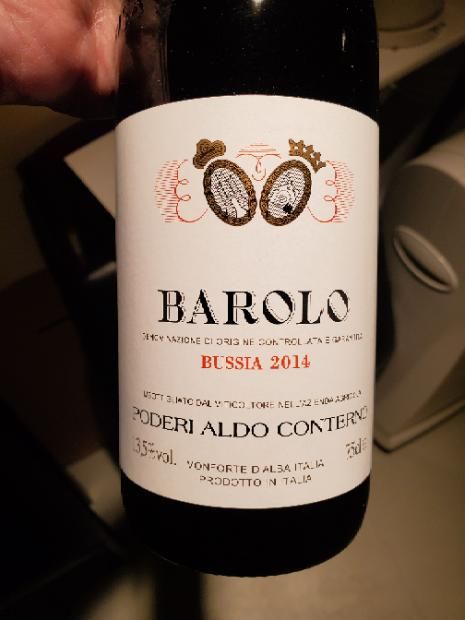
External search
Google (images)
Wine Advocate
Wine Spectator
Burghound
Wine-Searcher
Vintages
2019
2018
2017
2016
2015
2014
2013
2012
2011
2010
2009
2008
2006
2005
2004
2001
2000
1999
1998
1997
Show more
From this producer
Show all wines
All tasting notes
|
| Drinking Windows and Values |
| Drinking window: Drink between 2027 and 2042 (based on 206 user opinions) |
| Community Tasting History |
| Poderi Aldo Conterno Producer website
U.S. Importer/DistributorPoderi Aldo Conterno Barolo Riserva GranbussiaBAROLO RISERVA GRANBUSSIA DOCG
INTRODUCTION
The Barolo of the “Granbussia” selection is produced by assembling the distinctly vinified and aged wines of the vineyards Romirasco, Cicala and Colonnello in the following percentages respectively: 70%, 15% and 15%; however, these ideal values change according to the vintage.
The wine remains for 6 years in the cellar before being sold, and it is produced exclusively in the best vintages.
VINEYARD PROFILE
Vineyards: Romirasco, Cicala and Colonnelo
Varieties: Nebbiolo, Michet and Lampia varieties.
WINEMAKER NOTES
Vinification: red, with skin soaking inside stainless steel vats.
Fermentation: the must stays on contact with the skins for 15 days: during this time the alcoholic fermentation usually gets fully complete, and the wine is then drawn off.
Fermentation Temperatures: changeable, with highest peaks of 32 degrees centigrade.
Cellar Refining: the new wine remains inside stainless steel vats for 3 to 5 months, and it is periodically transferred before being put into big Slavonian oak barrels, where it is left aging for 36 months.
HARVEST NOTES
Harvest: manual, with grape selection in the vineyard.
Time of Harvest: mid-October.
TECHNICAL INFORMATION
alcoholic content % Vol. 13.00 – 14.50
Total acidity gr./lt. 5.5 – 6.5
pH 3.20 – 3.40NebbioloNebbiolo is a red grape indigenous to the Piedmont region of Italy in the Northwest. The grape can also be found in other parts of the world, though they are not as respected.
Nebbiolo is often considered the "king of red wines," as it is the grape of the famed wines of Barolo DOCG, Barbaresco DOCG, and Roero DOCG. It is known for high tannins and acidity, but with a distinct finesse. When grown on clay, Nebbiolo can be very powerful, tannic, and require long aging periods to reach its full potential. When grown on sand, the grape exhibits a more approachable body with more elegant fruit and less tannins, but still has high aging potential.
"Nebbiolo" is named for the Italian word, "nebbia", which means "fog", in Italian and rightfully so since there is generally a lot of fog in the foothills of Piedmont during harvest.
Nebbiolo is a late-ripening variety that does best in a continental climate that boasts moderate summers and long autumns. In Piedmont, Nebbiolo is normally harvested in October.
More links:
Varietal character (Appellation America) | Nebbiolo on CellarTrackerRiserva GranbussiaGranbussia is from the vineyards Romirasco, Cicala, Colonnello in Monforte d'Alba See the vineyards on weinlagen-infoItaly Italian Wines (ItalianMade.com, The Italian Trade Commission) | Italian Wine Guide on the WineDoctorPiedmont Vignaioli Piemontesi (Italian only)
On weinlagen-infoLanghe Consorzio di Tutela Barolo Barbaresco Alba Langhe e Roero | Union of Producers of Albese Wines (Albeisa)BaroloRegional History:
The wines of Piedmont are noted as far back as Pliny's Natural History. Due to geographic and political isolation, Piedmont was without a natural port for most of its history, which made exportation treacherous and expensive. This left the Piedmontese with little incentive to expand production. Sixteenth-century records show a mere 14% of the Bassa Langa under vine -- most of that low-lying and farmed polyculturally. In the nineteenth century the Marchesa Falletti, a frenchwoman by birth, brought eonologist Louis Oudart from Champagne to create the first dry wines in Piemonte. Along with work in experimental vineyards at Castello Grinzane conducted by Camilo Cavour -- later Conte di Cavour, leader of the Risorgimento and first Prime Minister of Italy -- this was the birth of modern wine in the Piedmont. At the heart of the region and her reputation are Alba and the Langhe Hills. This series of weathered outcroppings south of the Tanaro River is of maritime origin and composed mainly of limestone, sand and clay, known as terra bianca. In these soils -located mainly around the towns of Barolo and Barbaresco -- the ancient allobrogica, now Nebbiolo, achieves its renowned fineness and power.
map of Barolo DOCG
An interesting thread on Traditional vs. Modern Barolo producers:
https://www.wineberserkers.com/forum/viewtopic.php?f=1&t=106291 |
|




